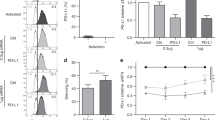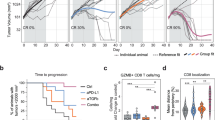Abstract
Foxp3, a member of the forkhead transcription factor family, is a master gene that controls the development and function of CD4+CD25+ regulatory T (Treg) cells. It is thought to contribute to pathogenesis of many different tumors, including ovarian carcinoma and pancreatic, breast and pancreatic ductal adenocarcinoma. Selectively depleted Foxp3-expressing cells with anit-CD25 antibodies or vaccination of Foxp3 mRNA-transfected dendritic cells engender protective immunity against tumor. This study targeted silencing Foxp3 gene expression using RNA interference (RNAi) delivered by a lentiviral vector to evaluate the therapeutic role of Foxp3 short-hairpin RNAs (shRNAs) in a murine model of leukemia. RL♂1, a mouse CD4+CD25+ leukemia cell with Foxp3 expression, was used as the leukemia animal model. By infecting RL♂1 cells with Lenti-Foxp3-siRNA, we reduced Foxp3 gene expression and the suppressive function of CD4+CD25− effector cells stimulated with ConA. Moreover, lentiviral-mediated Foxp3 RNAi transduced into RL♂1 cell or injected into the tumor showed suppressive effects on tumor growth and prolonged the survival of tumor-transplanted mice. However, this suppressive effect was abrogated in NOD-SCID mice transplanted with Lenti-Foxp3-siRNA-infected RL♂1 cells. In conclusion, inhibiting Foxp3 gene expression by shRNAs effectively decreases tumor growth of Treg cell-like leukemia. The results may provide a novel strategy for future immunotherapy against cancers.
This is a preview of subscription content, access via your institution
Access options
Subscribe to this journal
Receive 12 print issues and online access
$259.00 per year
only $21.58 per issue
Buy this article
- Purchase on Springer Link
- Instant access to full article PDF
Prices may be subject to local taxes which are calculated during checkout







Similar content being viewed by others
References
Kersey JH . Fifty years of studies of the biology and therapy of childhood leukemia. Blood 1997; 90: 4243–4251.
Hanahan D, Weinberg RA . The hallmarks of cancer. Cell 2000; 100: 57–70.
Hahn WC, Weinberg RA . Rules for making human tumor cells. N Engl J Med 2002; 347: 1593–1603.
Smith SD, Uyeki EM, Lowman JT . Colony formation in vitro by leukemic cells in acute lymphoblastic leukemia (ALL). Blood 1978; 52: 712–718.
Smith SD, Shatsky M, Cohen PS, Warnke R, Link MP, Glader BE . Monoclonal antibody and enzymatic profiles of human malignant T-lymphoid cells and derived cell lines. Cancer Res 1984; 44 (12 Pt 1): 5657–5660.
Lange B, Valtieri M, Santoli D, Caracciolo D, Mavilio F, Gemperlein I et al. Growth factor requirements of childhood acute leukemia: establishment of GM-CSF-dependent cell lines. Blood 1987; 70: 192–199.
Gjerset R, Yu A, Haas M . Establishment of continuous cultures of T-cell acute lymphoblastic leukemia cells at diagnosis. Cancer Res 1990; 50: 10–14.
Dialynas DP, Lee MJ, Gold DP, Shao Le, Yu AL, Borowitz MJ et al. Pre-conditioning with fetal cord blood facilitates engraftment of primary childhood T-cell acute lymphoblastic leukemia in immuno-deficient mice. Blood 2001; 97: 3218–3225.
Burnet FM . The concept of immunologic surveillance. Prog Exp Tumor Res 1970; 13: 1–27.
Smyth MJ, Dunn GP, Schreiber RD . Cancer immuno-surveillance and immuno-editing: the roles of immunity in suppressing tumor development and shaping tumor immunogenicity. Adv Immunol 2006; 90: 1–50.
Bui JD, Schreiber RD . Cancer immuno-surveillance, immuno-editing and inflammation: independent or interdependent processes? Curr Opin Immunol 2007; 19: 203–208.
Sakaguchi S . Naturally arising Foxp3-expressing CD25+CD4+ regulatory T cells in immunological tolerance to self and non-self. Nat Immunol 2005; 6: 345–352.
Wang X, Zheng J, Liu J, Yao J, He Y, Li X et al. Increased population of CD4(+)CD25(high), regulatory T cells with their higher apoptotic and proliferating status in peripheral blood of acute myeloid leukemia patients. Eur J Haematol 2005; 75: 468–476.
Nelson BH . IL-2, regulatory T cells, and tolerance. J Immunol 2004; 172: 3983–3988.
Prevosto C, Zancolli M, Canevali P, Zocchi MR, Poggi A . Generation of CD4+ or CD8+ regulatory T cells upon mesenchymal stem cell-lymphocyte interaction. Haematologica 2007; 92: 881–888.
Fontenot JD, Rudensky AY . A well-adapted regulatory contrivance: regulatory T cell development and the forkhead family transcription factor Foxp3. Nat Immunol 2005; 6: 331–337.
Hill JA, Feuerer M, Tash K, Haxhinasto S, Perez J, Melamed R et al. Foxp3 transcription-factor-dependent and -independent regulation of the regulatory T cell transcriptional signature. Immunity 2007; 27: 786–800.
Nik Tavakoli N, Hambly BD, Sullivan DR, Bao S . Forkhead box protein 3: essential immune regulatory role. Int J Biochem Cell Biol 2008; 40: 2369–2373.
Liyanage UK, Moore TT, Joo HG, Tanaka Y, Herrmann V, Doherty G et al. Prevalence of regulatory T cells is increased in peripheral blood and tumor microenvironment of patients with pancreas or breast adenocarcinoma. J Immunol 2002; 169: 2756–2761.
Curiel TJ, Coukos G, Zou L, Alvarez X, Cheng P, Mottram P et al. Specific recruitment of regulatory T cells in ovarian carcinoma fosters immune privilege and predicts reduced survival. Nat Med 2004; 10: 942–949.
Hiraoka N, Onozato K, Kosuge T, Hirohashi S . Prevalence of FOXP3+ regulatory T cells increases during the progression of pancreatic ductal adenocarcinoma and its pre-malignant lesions. Clin Cancer Res 2006; 12: 5423–5434.
Grauer OM, Nierkens S, Bennink E, Toonen LW, Boon L, Wesseling P et al. CD4+FoxP3+ regulatory T cells gradually accumulate in gliomas during tumor growth and efficiently suppress antiglioma immune responses in vivo. Int J Cancer 2007; 121: 95–105.
Hinz S, Pagerols-Raluy L, Oberg HH, Ammerpohl O, Grüssel S, Sipos B et al. Foxp3 expression in pancreatic carcinoma cells as a novel mechanism of immune evasion in cancer. Cancer Res 2007; 67: 8344–8350.
Roncador G, Garcia JF, Garcia JF, Maestre L, Lucas E, Menarguez J et al. FOXP3, a selective marker for a subset of adult T-cell leukemia/lymphoma. Leukemia 2005; 19: 2247–2253.
Chen S, Ishii N, Ine S, Ikeda S, Fujimura T, Ndhlovu LC et al. Regulatory T cell-like activity of Foxp3+ adult T cell leukemia cells. Int Immunol 2006; 18: 269–277.
Yano H, Ishida T, Inagaki A, Ishii T, Kusumoto S, Komatsu H et al. Regulatory T-cell function of adult T-cell leukemia/lymphoma cells. Int J Cancer 2007; 120: 2052–2057.
Ono M, Yaguchi H, Ohkura N, Kitabayashi I, Nagamura Y, Nomura T et al. Foxp3 controls regulatory T-cell function by interacting with AML1/Runx1. Nature 2007; 446: 685–689.
Pandiyan P, Zheng L, Ishihara S, Reed J, Lenardo MJ . CD4(+)CD25(+)Foxp3(+) regulatory T cells induce cytokine deprivation-mediated apoptosis of effector CD4(+) T cells. Nat Immunol 2007; 8: 1353–1362.
Nair S, Boczkowski D, Fassnacht M, Pisetsky D, Gilboa E . Vaccination against the forkhead family transcription factor Foxp3 enhances tumor immunity. Cancer Res 2007; 67: 371–380.
Sato H, Boyse EA, Aoki T, Iritani C, Old LJ . Leukemia-associated transplantation antigens related to murine leukemia virus. The X.1 system: immune response controlled by a locus linked to H-2. J Exp Med 1973; 138: 593–606.
Iwakuma T, Cui Y, Chang LJ . Self-inactivating lentiviral vectors with U3 and U5 modifications. Virology 1999; 261: 120–132.
Roush W . Anti-sense aims for a renaissance. Science 1997; 276: 1192–1193.
Brunkow ME, Jeffery EW, Hjerrild KA, Paeper B, Clark LB, Yasayko SA et al. Disruption of a new forkhead/winged-helix protein, scurfin, results in the fatal lymphoproliferative disorder of the scurfy mouse. Nat Genet 2001; 27: 68–73.
Berger CL, Tigelaar R, Cohen J, Mariwalla K, Trinh J, Wang N et al. Cutaneous T-cell lymphoma: malignant proliferation of T-regulatory cells. Blood 2005; 105: 1640–1647.
Wu Y, Borde M, Heissmeyer V, Feuerer M, Lapan AD, Stroud JC et al. FOXP3 controls regulatory T cell function through cooperation with NFAT. Cell 2006; 126: 375–387.
Zheng Y, Josefowicz SZ, Kas A, Chu TT, Gavin MA, Rudensky AY et al. Genome-wide analysis of Foxp3 target genes in developing and mature regulatory T cells. Nature 2007; 445: 936–940.
Pandiyan P, Zheng L, Ishihara S, Reed J, Lenardo MJ . CD4+CD25+Foxp3+ regulatory T cells induce cytokine deprivation-mediated apoptosis of effector CD4+ T cells. Nat Immunol 2007; 8: 1353–1362.
Alisky JM, Davidson BL . Towards therapy using RNA interference. Am J Pharmacogenomics 2004; 4: 45–51.
Abbas-Terki T, Blanco-Bose W, Deglon N, Pralong W, Aebischer P . Lentiviral-mediated RNA interference. Hum Gene Ther 2002; 13: 2197–2201.
Rubinson DA, Dillon CP, Kwiatkowski AV, Sievers C, Yang L, Kopinja J et al. A lentivirus-based system to functionally silence genes in primary mammalian cells, stem cells and transgenic mice by RNA interference. Nat Genet 2003; 33: 401–406.
Heller LC, Ingram SF, Lucas ML, Gilbert RA, Heller R . Effect of electrically mediated intratumor and intramuscular delivery of a plasmid encoding IFN alpha on visible B16 mouse melanomas. Technol Cancer Res Treat 2002; 1: 205–209.
Tomar RS, Matta H, Chaudhary PM . Use of adeno-associated viral vector for delivery of small interfering RNA. Oncogene 2003; 22: 5712–5715.
Maynard CL, Harrington LE, Janowski KM, Oliver JR, Zindl CL, Rudensky AY et al. Regulatory T cells expressing interleukin 10 develop from Foxp3+ and Foxp3- precursor cells in the absence of interleukin 10. Nat Immunol 2007; 8: 931–941.
Jackson AL, Bartz SR, Schelter J, Kobayashi SV, Burchard J, Mao M et al. Expression profiling reveals off-target gene regulation by RNAi. Nat Biotechnol 2003; 21: 635–637.
Persengiev SP, Zhu X, Green MR . Non-specific, concentration-dependent stimulation and repression of mammalian gene expression by small interfering RNAs (siRNAs). RNA 2004; 10: 12–18.
Tomayko MM, Reynolds CP . Determination of subcutaneous tumor size in athymic (nude) mice. Cancer Chemother Pharmacol 1989; 24: 148–154.
Author information
Authors and Affiliations
Corresponding author
Ethics declarations
Competing interests
The authors declare no conflict of interest.
Rights and permissions
About this article
Cite this article
Tsai, BY., Suen, JL. & Chiang, BL. Lentiviral-mediated Foxp3 RNAi suppresses tumor growth of regulatory T cell-like leukemia in a murine tumor model. Gene Ther 17, 972–979 (2010). https://doi.org/10.1038/gt.2010.38
Received:
Revised:
Accepted:
Published:
Issue Date:
DOI: https://doi.org/10.1038/gt.2010.38
Keywords
This article is cited by
-
FOXP3 knockdown inhibits the proliferation and reduces NOTCH1 expression of T cell acute lymphoblastic leukemia cells
BMC Research Notes (2018)
-
Therapeutic blockade of Foxp3 in experimental breast cancer models
Breast Cancer Research and Treatment (2017)
-
Progress in RNAi-mediated Molecular Therapy of Acute and Chronic Myeloid Leukemia
Molecular Therapy - Nucleic Acids (2015)
-
MED19 promotes proliferation and tumorigenesis of lung cancer
Molecular and Cellular Biochemistry (2011)



